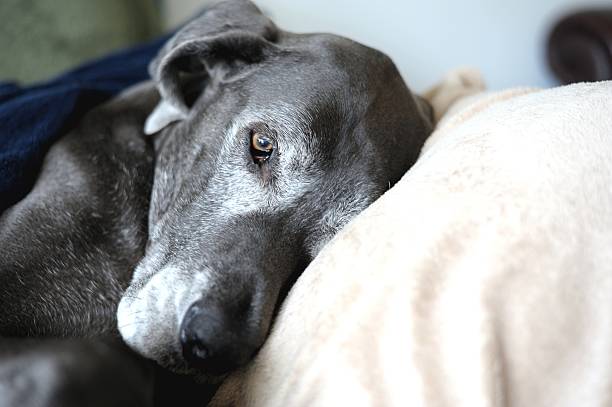As dogs age, they can develop seizures due to underlying medical conditions. Brain tumors press on tissue and cause old Dog Seizures by disrupting normal electrical brain activity. Dementia can also spark seizure activity as the brain declines.
Liver or kidney disease leads to toxin buildup in a dog’s body which affects brain function. Idiopathic epilepsy, meaning seizures with no known cause, also becomes more common in older dogs.
If your senior dog is experiencing seizures, stay calm through the episode and take your dog to the vet for an examination and diagnostic testing to determine the cause.

Types of Seizures in Old Dogs
Old dogs can experience different types of seizures, including generalized seizures, focal seizures, and cluster seizures.
Generalized Seizures
Old dogs can get generalized seizures. The whole brain gets hit with a wave of electric shocks. The dog shakes all over, may pee or poop, and could fall down too. This seizure takes from seconds to minutes only.
After the event, the old dog looks tired and confused for quite some time.
Focal Seizures
Focal seizures, also known as partial seizures, are a type of seizure that starts in a specific area of the brain. These seizures can affect one side or one part of your old dog’s body.
During a focal seizure, your dog may experience muscle twitching, jerking, or stiffening in their legs or face. They may also drool, chomp or foam at the mouth, and chew their tongue.
While some dogs remain conscious during these seizures, others may lose consciousness for a short time. It’s important to monitor your old dog closely during a focal seizure and keep them safe from any potential hazards.
Cluster Seizures
Cluster seizures are a type of seizure that occurs in quick succession or back-to-back. They can be quite alarming to witness, as your old dog may have multiple seizures within a short period.
During these episodes, your dog may experience muscle twitching, jerking or stiffening, loss of consciousness, drooling, chomping or foaming at the mouth, and tongue chewing. It is important to stay calm and ensure your dog’s safety during cluster seizures by removing any hazards nearby.
Monitoring the duration and intensity of the seizures is also crucial for providing accurate information to your veterinarian. Treatment options for cluster seizures may include medication adjustments or other supportive therapies prescribed by your vet.
Identifying a Seizure in Your Old Dog
To identify a seizure in your old dog, look for symptoms such as muscle twitching, jerking or stiffening, drooling, chomping or foaming at the mouth, and tongue chewing.
Symptoms to look for
Old dog seizures can be a frightening experience for both you and your furry friend. It’s important to know the symptoms of a seizure so that you can provide proper care and support.
During a seizure, your old dog may experience loss of consciousness, muscle twitching, jerking or stiffening, drooling, chomping or foaming at the mouth, and tongue chewing. These symptoms are often accompanied by confusion and disorientation.
If you notice any of these signs in your older dog, it’s crucial to stay calm and ensure their safety until the seizure passes.
What a seizure may look like?
During a seizure, your old dog may experience different symptoms. They might lose consciousness or appear disoriented. Their muscles could start twitching or jerking uncontrollably.
Drooling, chomping or foaming at the mouth are also common signs. You may notice them chewing their tongue or collapsing during a seizure too. Seizures can be scary to witness, but it’s important to stay calm and ensure your dog’s safety throughout the episode.
Different phases of a seizure
During a seizure, your old dog may go through different phases. The first phase is called the pre-ictal phase, where your dog’s behavior might change and they could appear restless or anxious.
This is followed by the ictal phase, which is when the actual seizure occurs. Your dog may experience muscle twitching, jerking, stiffness, or loss of consciousness during this phase.
Finally, there’s the post-ictal phase, where your dog may be disoriented or tired after the seizure. It’s important to monitor your dog closely during these phases and ensure their safety until the seizure has passed.
Causes of Seizures in Old Dogs
Brain tumors, metabolic disorders, toxins, epilepsy, traumatic brain injury, and thromboembolic events can all cause seizures in old dogs. Learn more about these causes and how to help your dog by reading the full article.

Brain Tumors
Brain tumors can be a cause of seizures in old dogs. These are abnormal growths that form in the brain and can put pressure on surrounding tissues. The symptoms of brain tumors may vary depending on their location, but they can include seizures, changes in behavior or personality, difficulty walking, and loss of coordination.
Treatment options for brain tumors may include surgery to remove the tumor, radiation therapy, or medications to manage symptoms.
It’s important to consult with your veterinarian if you suspect your old dog may have a brain tumor so that proper diagnosis and treatment can be provided.
Metabolic Disorders
Metabolic disorders can be a cause of seizures in old dogs. These disorders affect the way your dog’s body processes and uses nutrients, leading to imbalances or deficiencies. When these imbalances occur, it can disrupt the normal functioning of your dog’s brain and nervous system, increasing the risk of seizures.
Some common metabolic disorders that can trigger seizures include liver disease, kidney disease, low blood sugar (hypoglycemia), and electrolyte imbalances. It’s important to work closely with your veterinarian to diagnose and manage any underlying metabolic conditions to help reduce the frequency and severity of seizures in your old dog.
Toxins
Toxins can also trigger seizures in old dogs. Certain substances, such as insecticides, pesticides, cleaning products, and certain human foods like chocolate or grapes, can be toxic to dogs and cause neurological issues.
Exposure to everyday household items like certain plants or medications can be harmful. It’s important to keep these toxins out of your dog’s reach and ensure they are not exposed to them.
If you suspect your dog has ingested something toxic, contact your veterinarian immediately for guidance on what steps to take next.
Epilepsy
Epilepsy is one of the causes of seizures in old dogs. It is a neurological disorder characterized by recurrent, unprovoked seizures. These seizures can vary in severity and frequency.
The exact cause of epilepsy in dogs is often unknown, but it may be genetic or caused by brain abnormalities. Old dogs with epilepsy may experience muscle twitching, loss of consciousness, jerking or stiffening of their body, drooling, chomping or foaming at the mouth, and tongue chewing during a seizure.
If your old dog has epilepsy, treatment options include medication to manage and reduce the frequency of seizures, as well as other supportive therapies like natural supplements and diet changes.
Traumatic brain injury
Traumatic brain injury can also lead to seizures in old dogs. This happens when the brain gets injured due to a blow or trauma to the head. It could be from an accident, fall, or any other kind of impact.
When this occurs, it disrupts the normal functioning of the brain and can result in seizures. Traumatic brain injuries should be taken seriously and require immediate veterinary attention.
Treatment options will depend on the severity of the injury and may include medication, supportive therapies, and close monitoring of your dog’s condition. Providing a safe environment for your dog is crucial during their recovery process.
Thromboembolic Events
Thromboembolic events are a possible cause of seizures in old dogs. These events happen when there is a blood clot that blocks a blood vessel in the brain, cutting off the blood supply.
This can lead to a seizure because the brain doesn’t get enough oxygen and nutrients. Thromboembolic events can be caused by underlying health conditions like heart disease or cancer, so it’s important to have your dog checked by a vet if they experience seizures.
Treatment options for thromboembolic events may include medication to prevent clots from forming and surgery to remove existing clots. It’s crucial to work closely with your vet to manage this condition and reduce the risk of future seizures in your old dog.

How to Help Your Old Dog During a Seizure?
Ensure the safety of your old dog by removing any potential hazards or objects that may cause injury during the seizure.
Ensuring Safety
During a seizure, it’s important to make sure your old dog is safe. Remove any objects that could harm them and create a cushioned area for them to lie on. Stay calm and speak softly to reassure your dog.
Avoid touching their mouth or restraining them, as this may cause injury. Keep track of the duration of the seizure and any unusual behavior afterward so you can inform your vet.
Monitoring the seizure
During a seizure, it’s important to monitor your old dog closely. Watch for any changes in their behavior or physical signs. Keep an eye on the duration of the seizure and take note of any unusual symptoms that occur during this time.
Stay near your dog to ensure their safety and prevent them from bumping into objects or falling down. Resist the urge to intervene physically unless necessary, as it may provoke further distress.
Instead, offer soothing words and stay calm to help relax your dog during the episode.
Calming your dog
During a seizure, it’s important to stay calm and help your old dog feel safe. First, ensure the area around them is clear of any objects that could harm them during the seizure.
Avoid touching or restraining your dog because this could potentially worsen their distress. Instead, try speaking softly and reassuringly to them to provide comfort. Keep in mind that most seizures only last for a few minutes, so it’s important to monitor the duration of the seizure and take note of any changes or unusual behaviors.
Once the seizure has ended, allow your dog some time to rest and recover in a quiet environment.
Treatment Options for Seizures in Old Dogs
Treatment options for seizures in old dogs include medication, natural supplements, diet changes, possible surgery, and other supportive therapies.
Medication
Medication can be an important part of treating seizures in old dogs. Your vet may prescribe anti-seizure medications to help control your dog’s seizures. These medications work by reducing the electrical activity in the brain that causes seizures.
It’s important to follow your vet’s instructions carefully and give the medication as directed. Remember that it may take some time to find the right medication and dosage for your dog, so be patient and continue working closely with your vet to find the best treatment plan for your furry friend.
Natural Supplements
Natural supplements can be a helpful option for managing seizures in old dogs. Some common natural supplements that are used include CBD oil, which is derived from hemp and has been shown to reduce seizure activity in some dogs.
Another supplement is melatonin, which can help regulate sleep patterns and may have a calming effect on the brain. Additionally, omega-3 fatty acids have anti-inflammatory properties that can benefit dogs with seizures.
Always consult with your veterinarian before starting any new supplements to ensure they are safe and appropriate for your dog’s specific needs.
Diet Changes
Older dogs experiencing seizures may benefit from certain diet changes. Consult your veterinarian to create a suitable meal plan for your furry friend. They might recommend a diet low in carbohydrates and high in healthy fats, such as omega-3 fatty acids.
These fats have anti-inflammatory properties that can reduce seizure frequency. Additionally, your vet may suggest avoiding certain trigger foods or ingredients, like artificial additives or grains.
Remember to gradually introduce any dietary changes to prevent stomach upset and monitor your dog’s response closely.
Possible Surgery
In some cases, surgery may be an option for treating seizures in old dogs. This is usually considered when the seizures are caused by a brain tumor or a traumatic brain injury that can be addressed surgically.
The decision to proceed with surgery will depend on various factors, including the overall health of your dog and the risks involved. It’s important to consult with your veterinarian and possibly a veterinary neurologist to determine if surgery is a viable treatment option for your old dog’s seizures.
Other supportive therapies
In addition to medication and natural supplements, other supportive therapies can help manage seizures in old dogs. These include acupuncture, chiropractic care, and physical therapy.
Acupuncture involves the placement of small needles in specific points on the body to promote healing and pain relief. Chiropractic care focuses on aligning the spine to improve overall health and well-being.
Physical therapy uses exercises and stretches to strengthen muscles and improve mobility. These therapies can be used alongside traditional treatment options to provide holistic support for your old dog’s seizure management plan.

Preventing Seizures in Old Dogs
To prevent seizures in old dogs, create a safe environment for them, schedule regular vet check-ups, and manage any underlying health conditions they may have.
Keeping your dog in a safe environment
To keep your dog safe from seizures, it’s important to create a safe environment for them. Remove any potential hazards that could trigger a seizure, such as sharp objects or toxic substances.
Make sure your home is well-maintained and free of clutter to prevent your dog from accidentally bumping into things during a seizure. Secure fences and gates in your yard to prevent them from wandering off during a seizure.
It’s also a good idea to provide padded areas where your dog can rest comfortably during or after a seizure. By taking these precautions, you can help ensure the safety of your beloved furry friend.
Regular vet check-ups
Regular vet check-ups are crucial for old dogs, as they help identify any underlying health conditions and monitor the overall well-being of your furry friend.
During these visits, the vet will conduct a thorough examination, which may include blood tests, imaging scans, and neurological evaluations to detect any potential seizures or seizure triggers.
They can also guide preventive measures and recommend appropriate treatments or medications if needed. By staying proactive with regular vet check-ups, you can ensure your old dog receives the necessary care and support to manage their seizures effectively.
Managing underlying health conditions
To help prevent seizures in old dogs, it’s important to manage their underlying health conditions. Regular visits to the vet can identify any issues early on and ensure proper care.
This includes monitoring and controlling chronic diseases like diabetes or kidney problems, as well as addressing any metabolic disorders that may be contributing to seizures.
Following a veterinarian-recommended treatment plan can greatly reduce the risk of seizures in older dogs and improve their overall quality of life.
Conclusion
In conclusion, understanding old dog seizures is crucial for pet owners. By recognizing the symptoms and knowing the possible causes, you can help your furry friend get the necessary treatment and support they need.
Remember to consult with your vet about treatment options that will best suit your dog’s individual needs.
FAQs
1. What Causes Seizures In Older Dogs?
Common causes include brain tumors, liver or kidney failure, infections, brain inflammation, and idiopathic epilepsy.
2. What Happens When An Old Dog Has A Seizure?
Seizures involve losing consciousness, collapsing, muscle rigidity/jerking, drooling, chomping, and loss of bowel control.
3. How Long Do Seizures Normally Last In Dogs?
Anywhere from less than a minute to several minutes. Most end within 2-3 minutes.
4. What Should I Do If My Senior Dog Has A Seizure?
Stay calm, comfort your dog, protect them from injury, and call the vet immediately afterward.
5. How Can I Reduce Seizures In An Older Dog?
Your vet may prescribe anti-seizure medication. Address any underlying conditions. Avoid seizure triggers.
6. Is Euthanasia Ever Recommended For Uncontrollable Seizures?
If seizures can’t be managed medically and quality of life is very poor, euthanasia may be an option.
7. Can I Stop A Dog Seizure Once It Starts?
No, you should not restrain or attempt to stop a seizure already in progress.
8. Will Seizures Shorten My Older Dog’s Lifespan?
Difficult to control seizure disorders can potentially reduce lifespan. Work closely with your vet.
9. Is There A Dog Seizure Diet I Should Follow?
Your vet may recommend an anti-seizure diet. Diets high in good fats may help.
10. How Often Should My Senior Dog See The Vet For Seizure Monitoring?
Your vet will advise checkups every 6-12 months, or more often if seizures are not well-controlled.
Author Profile
- Site Owner And Dog Lover
-
Aritra, the founder of Labradorandyou.com, is a lifelong dog lover whose passion ignited for Labradors for their loyalty and intelligence. With extensive research and personal experiences, Aritra has become a Labrador expert, offering a rich resource on the breed. Labradorandyou.com provides reliable, timely, and evidence-based information, including Labrador-specific product reviews, training techniques, and care tips.
Labradorandyou.com was born out of Aritra's passion and his desire to share his profound knowledge about the breed. The site serves as a comprehensive resource, offering a wealth of up-to-date information for Labrador owners and enthusiasts alike
Also by the author
-
 Lab-TypesNovember 17, 2023Old Dog Seizures: Causes, Symptoms, and Treatment Options
Lab-TypesNovember 17, 2023Old Dog Seizures: Causes, Symptoms, and Treatment Options
-
 Lab-TypesNovember 17, 2023Why Is My Dogs Poop Yellow? 8 Reasons & Solutions
Lab-TypesNovember 17, 2023Why Is My Dogs Poop Yellow? 8 Reasons & Solutions
-
 ReviewsNovember 17, 2023The Only Hill’s Science Diet Review You Need To Read
ReviewsNovember 17, 2023The Only Hill’s Science Diet Review You Need To Read
-
 Lab-TypesNovember 17, 2023How To Adopt An Emotional Support Dog?
Lab-TypesNovember 17, 2023How To Adopt An Emotional Support Dog?





